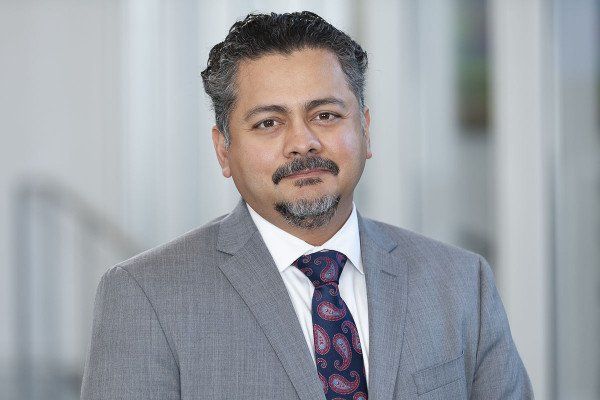Part 1: Benefit Shown With Transplant and Combination Therapy in Multiple Myeloma
During a live virtual event, Saad Zafar Usmani, MD, discussed 2 studies of drug combinations in patients with multiple myeloma with or without stem cell transplants.
Saad Zafar Usmani, MD
Director, Plasma Cell Disorders Program
Director, Clinical Research in Hematologic Malignancies
Levine Cancer Institute/Carolinas Healthcare System
Charlotte, NC

Targeted OncologyTM: Can you discuss the IFM/DCFI2009 study?
The IFM/DCFI2009 study [NCT01191060], which was originally presented for the first time 5 years ago, was published in the New England Journal of Medicine in 2017.1,2 It was looking at RVd [lenalidomide (Revlimid), bortezomib (Velcade), and dexamethasone] as induction for 3 cycles, followed by transplant, and comparing that [with] RVd for a total of 8 cycles with stem cell mobilization and collection, then both arms went on to get lenalidomide. The progression-free survival [PFS] and the response benefit were certainly in favor of early transplantation in this group. More recently, these data were updated showing that the PFS benefit continues to be in favor of the transplant arm, and given the fact that this disease has now a median survival of well over 10 years, there were still no differences at the 8-year mark for overall survival [OS].1,2 That will be a continued challenge for demonstrating OS, because we have a lot of good options that patients can bank on when they’re relapsing.
The other important lesson we learned is about the quality of response. Minimal residual disease [MRD] negativity is not just numerically higher, but the MRD-negative patients in the transplant arm do much better than the MRD-negative patients in the RVd-alone arm.2,3 So, quality of response is better when you can incorporate a stem cell transplant in the frontline setting for patients. That’s another important message the recent update from the IFM/DCFI2009 study had shown us.
What were the design and results of the FORTE study?
I really like this study because of the many lessons we are learning from the FORTE trial [NCT02203643].4,5 Francesca Gay, MD, led this study. This was a 3-arm study, [with] patients being randomized to either 12 cycles of KRd [carfilzomib (Kyprolis), lenalidomide, and dexamethasone], or KRd for 4 cycles, followed by a stem cell transplant, then 4 cycles of KRd as consolidation. The third arm was KCd [carfilzomib, cyclophosphamide, and dexamethasone] for 4 cycles, then transplant and 4 cycles of KCd as consolidation. Then there is a second randomization between lenalidomide as maintenance [and] carfilzomib and lenalidomide as maintenance—so IMiD [immunomodulatory drugs] vs a proteasome inhibitor [PI]-IMiD maintenance schema.4,5
The initial results Dr Gay had shared with us at the 2020 American Society of Clinical Oncology Annual Meeting, and then updated them at the 2020 American Society of Hematology [ASH] Annual Meeting, showed the PFS being superior in the KRd transplant followed by KRd consolidation arm [HR, 0.53; 95% CI, 0.37-0.77; P < .001] compared [with] the KCd [HR, 0.64; 95% CI, 0.44-0.94; P = .023] and the KRd12 [HR, 0.82; 95% CI, 0.59-1.16; P = .262]. This stems from the fact that the quality of responses, as well as MRD negativity rates and sustained MRD negativity, was higher in the transplant arm of the study.5
These are the second randomization data that were presented. So, 356 patients were randomized to maintenance, and they were stratified based on premaintenance response so that there was no difference between the 2 arms. This study showed that the PI-IMiD maintenance is better in terms of PFS compared [with] lenalidomide maintenance [HR, 0.63; P = .026].5 This does not come as a surprise to me, as an Arkansan, because 11 years ago, when we were doing the total therapy studies, the PI-IMiDs were combined for maintenance, and that’s the best data set we had at that point in terms of outcomes. Now we’re seeing studies with more effective treatments or better-quality treatments showing the same kind of results.
The follow-up is still short on this study. The median follow-up is only [approximately] 31 months, so we’re not going to be seeing differences in subgroups. I would be curious to see where the benefit really comes from. Is it for standard-risk or high-risk patients? We don’t know just yet, and hopefully Dr Gay will continue to update us with these data later this year and next year.
References:
1. Attal M, Lauwers-Cances V, Hulin C, et al; IFM 2009 Study. Lenalidomide, bortezomib, and dexamethasone with transplantation for myeloma. N Engl J Med. 2017;376(14):1311-1320. doi:10.1056/NEJMoa1611750
2. Perrot A, Lauwers-Cances V, Cazaubiel T, et al. Early versus late autologous stem cell transplant in newly diagnosed multiple myeloma: long-term follow-up analysis of the IFM 2009 Trial. Blood. 2020;136(suppl 1):39. doi:10.1182/blood-2020-134538
3. Perrot A, Lauwers-Cances V, Corre J, et al. Minimal residual disease negativity using deep sequencing is a major prognostic factor in multiple myeloma. Blood. 2018;132(23):2456-2464. doi:10.1182/blood-2018-06-858613
4. Gay F, Cerrato C, Petrucci MT, et al. Efficacy of carfilzomib lenalidomide dexamethasone (KRd) with or without transplantation in newly diagnosed myeloma according to risk status: results from the FORTE trial. J Clin Oncol. 2019;37(suppl 15):8002. doi:10.1200/JCO.2019.37.15_suppl.8002
5. Gay F, Musto P, Scalabrini DR, et al. Survival analysis of newly diagnosed transplant-eligible multiple myeloma patients in the randomized Forte trial. Blood. 2020;136(suppl 1):35-37. doi:10.1182/blood-2020-136907